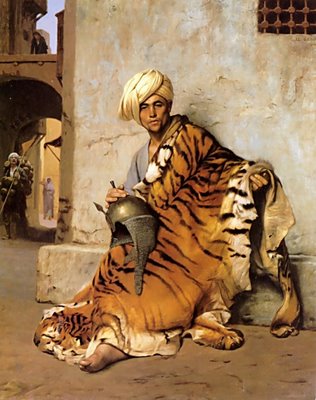 Napoleon Bonaparte's 1798 campaign in Egypt re-introduced the Islamic world to the attention of Western Europe. The following century saw a flourishing of Western interest in Islamic civilization. Many artists fetishized it as a culture of beauty, mystery, courage, and sensuality.
Napoleon Bonaparte's 1798 campaign in Egypt re-introduced the Islamic world to the attention of Western Europe. The following century saw a flourishing of Western interest in Islamic civilization. Many artists fetishized it as a culture of beauty, mystery, courage, and sensuality.One prominent Orientalist was Frenchman Jean-Leon Gerome. This is Pelt Merchant of Cairo, who entices the Western viewer with an example of the exotic goods and sights to be found in the Middle East.
 In an age of mass publishing and cheap international transportation -- including the revolutionary idea of tourism -- idealized portraits of an exotic culture across the Mediterranean were exciting. The development of the steam engine meant that for the wealthy, worldwide travel was actually feasible. This possibility fueled a hunger for the strange and the foreign.
In an age of mass publishing and cheap international transportation -- including the revolutionary idea of tourism -- idealized portraits of an exotic culture across the Mediterranean were exciting. The development of the steam engine meant that for the wealthy, worldwide travel was actually feasible. This possibility fueled a hunger for the strange and the foreign.Evening Prayer by Austria's Rudolf Ernst.

In the 18th Century, European philosophers like Jean-Jacques Rousseau developed the notion of the "noble savage" -- that civilization sapped the vitality out of masculinity, which is only fully realized among barbarians. An idealized concept of Islamic manhood is prominent in Orientalist art, as seen in Adolf Schreyer's Arab Warrior Leading a Charge.
 Middle Eastern social institutions, such as the harem and the Turkish bath (at least as they existed in the imaginations of Westerners) also provided artists with a contrived excuse to depict naked women, just as Greco-Roman mythology had served for centuries. This trend began with Jean Auguste Dominique Ingres' Odalisque and became a dominant Orientalist theme. 'Odalisque' is a a Frankification of the Turkish word odalik, meaning the junior-most slave in a harem.
Middle Eastern social institutions, such as the harem and the Turkish bath (at least as they existed in the imaginations of Westerners) also provided artists with a contrived excuse to depict naked women, just as Greco-Roman mythology had served for centuries. This trend began with Jean Auguste Dominique Ingres' Odalisque and became a dominant Orientalist theme. 'Odalisque' is a a Frankification of the Turkish word odalik, meaning the junior-most slave in a harem.
No comments:
Post a Comment